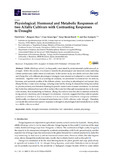Mostrar el registro sencillo del ítem
Physiological, hormonal and metabolic responses of two alfalfa cultivars with contrasting responses to drought
| dc.creator | Soba Hidalgo, David | es_ES |
| dc.creator | Zhou, Bangwei | es_ES |
| dc.creator | Arrese-Igor Sánchez, César | es_ES |
| dc.creator | Munné Bosch, Sergi | es_ES |
| dc.creator | Aranjuelo Michelena, Iker | es_ES |
| dc.date.accessioned | 2020-05-19T06:57:53Z | |
| dc.date.available | 2020-05-19T06:57:53Z | |
| dc.date.issued | 2019 | |
| dc.identifier.issn | 1661-6596 | |
| dc.identifier.uri | https://hdl.handle.net/2454/36909 | |
| dc.description.abstract | Alfalfa (Medicago sativa L.) is frequently constrained by environmental conditions such as drought. Within this context, it is crucial to identify the physiological and metabolic traits conferring a better performance under stressful conditions. In the current study, two alfalfa cultivars (San Isidro and Zhong Mu) with different physiological strategies were selected and subjected to water limitation conditions. Together with the physiological analyses, we proceeded to characterize the isotopic, hormone, and metabolic profiles of the different plants. According to physiological and isotopic data, Zhong Mu has a water-saver strategy, reducing water lost by closing its stomata but fixing less carbon by photosynthesis, and therefore limiting its growth under water-stressed conditions. In contrast, San Isidro has enhanced root growth to replace the water lost through transpiration due to its more open stomata, thus maintaining its biomass. Zhong Mu nodules were less able to maintain nodule N2 fixing activity (matching plant nitrogen (N) demand). Our data suggest that this cultivar-specific performance is linked to Asn accumulation and its consequent N-feedback nitrogenase inhibition. Additionally, we observed a hormonal reorchestration in both cultivars under drought. Therefore, our results showed an intra-specific response to drought at physiological and metabolic levels in the two alfalfa cultivars studied. | en |
| dc.description.sponsorship | This work was supported by the i-COOP-suelos y legumbres (2016SU0016) call funded by the National Research Council. David Soba is the recipient of a PhD grant supported by the Public University of Navarra | en |
| dc.format.extent | 19 p. | |
| dc.format.mimetype | application/pdf | en |
| dc.language.iso | eng | en |
| dc.publisher | MDPI | en |
| dc.relation.ispartof | International Journal of Molecular Sciences, 2019, 20 (20), 5099 | en |
| dc.rights | © 2019 by the authors. Licensee MDPI, Basel, Switzerland. This article is an open access article distributed under the terms and conditions of the Creative Commons Attribution (CC BY) | en |
| dc.rights.uri | http://creativecommons.org/licenses/by/4.0/ | |
| dc.subject | Alfalfa | en |
| dc.subject | Drought | en |
| dc.subject | Hormones | en |
| dc.subject | Metabolites | en |
| dc.subject | N/C metabolism | en |
| dc.subject | Nodule | en |
| dc.subject | Physiology | en |
| dc.title | Physiological, hormonal and metabolic responses of two alfalfa cultivars with contrasting responses to drought | en |
| dc.type | info:eu-repo/semantics/article | en |
| dc.type | Artículo / Artikulua | es |
| dc.contributor.department | Ciencias | es_ES |
| dc.contributor.department | Zientziak | eu |
| dc.contributor.department | Institute for Multidisciplinary Research in Applied Biology - IMAB | es_ES |
| dc.rights.accessRights | info:eu-repo/semantics/openAccess | en |
| dc.rights.accessRights | Acceso abierto / Sarbide irekia | es |
| dc.identifier.doi | 10.3390/ijms20205099 | |
| dc.relation.publisherversion | https://doi.org/10.3390/ijms20205099 | |
| dc.type.version | info:eu-repo/semantics/publishedVersion | en |
| dc.type.version | Versión publicada / Argitaratu den bertsioa | es |
| dc.contributor.funder | Universidad Pública de Navarra / Nafarroako Unibertsitate Publikoa | es |




